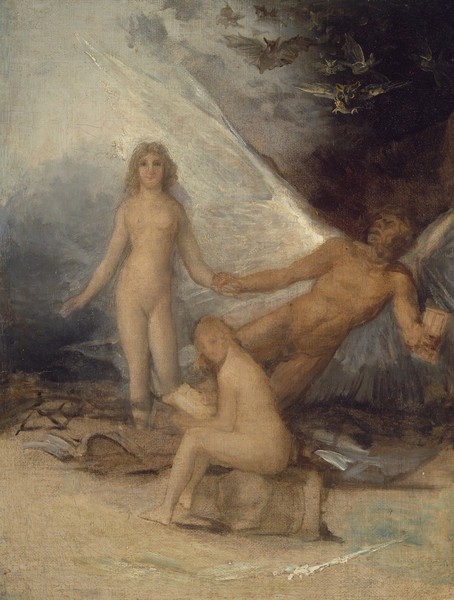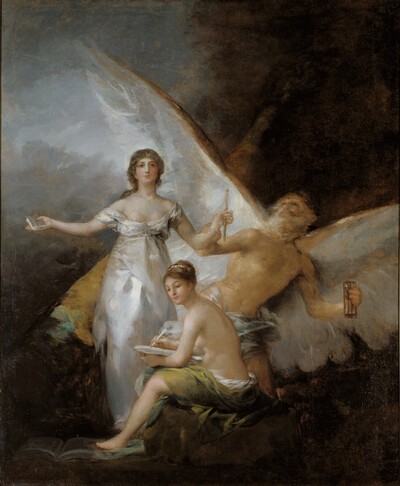- Cronología
- Ca. 1797 - 1799
- Ubicación
- Museum of Fine Arts, Boston, Boston, United States
- Dimensiones
- 41.6 x 32.7 cm
- Técnica y soporte
- Oil on canvas
- Reconocimiento de la autoría de Goya
- Undisputed work
- Titular
- Museum of Fine Arts
- Ficha: realización/revisión
- 22 Feb 2010 / 14 Jun 2023
- Inventario
- (27.1330)
This is a sketched study of a theme which in time would reach full development in another of Goya's large format paintings, Truth, Time and History. Goya gave this painting to Juan Carnicero from Madrid. Some time around 1875 it passed into the possession of Alejandro de Coupigny in Madrid. In 1918, Ralph W. Curtis bought it for Horatio Greenough Curtis for his Boston collection. It was inherited by his wife, and on 21 July 1927 she donated it to the Museum of Fine Arts in Boston.
The painting is dominated by ochre tones and a sketchy execution, and presents many variations in comparison to the large format work. Likewise, we can identify many alterations, which lead us to the conclusion that Goya's ideas were not particularly clear at the time when this piece was painted. While the essential elements of the composition are maintained in the final version, some changes are so significant that they have even caused confusion when it comes to identifying the subject. The most likely scenario is that Goya reworked this composition when he was painting Truth, Time and History, introducing the changes which he thought appropriate.
We are presented with three figures. The allegory of Time, winged and carrying an hourglass, has the face of a peaceful beast who looks up, frightened, at the menacing beings which fly above his head. We can identify various changes in this area; in fact, in the large format version Chronos has the head of a bearded man, and the fearsome bats and owls have disappeared altogether. From the position of his legs, it seems that he is floating at the level of the floor, while he saves a girl who he is holding by the hand from danger. This girl has been identified as Truth, since she is naked. Her face has been repainted several times during restoration work, and perhaps Goya's work has been excessively modified. In the definitive work, in her place we find a woman dressed in white with a sceptre and a small book in her hands. The visible brushstrokes around her body reveal the presence of a tunic or other kind of garment - another alteration made to this sketch. The third figure in this work is identified as an allegory of History. She is sitting with her back to the viewer on a piece of column, holding a large book. She is turning her head towards the viewer. This figure is also naked, and in the definitive work is barely covered from the waist down with a green cloth.
Time brings Truth forward out of the darkness, while History bears witness to the events. But the notable changes in the final canvas, which have led to various interpretations, make Juliet Wilson ask what Goya truly wished to represent in this sketch, and even consider that this is not in fact a sketch for the final piece, but an independent work whose final version was never painted, or a sketch on the theme of witches, given the similarities between this work and The Spell. From a stylistic and thematic point of views, it is also very close to the Caprices series. In particular, it can be associated with a drawing on the same theme, as it presents numerous similarities with the preparatory sketches for that series of prints.
Technically, the light effects which Goya wanted to express in this mysterious sketch have been lost, likewise the impasto brushwork, irreparably damaged during an overly aggressive restoration job.
The work has been relined. Until that time it must not have been framed, as can be seen from an archive photograph of the restoration work stored in the Boston Museum of Fine Arts.
-
Loan exhibition of Painting by El Greco and GoyaM. Knoedler and Co.New York1912April 1912cat. 13
-
The art of Goya. Paintings, drawings and printsThe Art Institute of ChicagoChicago1941from January 30th to March 2nd 1941cat. 59
-
El Greco to GoyaJohn Herron Museum of ArtIndianapolis1963from February 10th to March 24th 1963. Exhibited also at the Museum of Art, Rhode Island School of Design, Providence (Rhode Island), April 19th to May 26th 1963.cat. 28
-
Goya and his timesThe Royal Academy of ArtsLondon1963cat. 66cat. 83
-
The Changing Image: Prints by GoyaMuseum of Fine ArtsBoston1974From October to December 1974. Exhibited also at The National Gallery of Canada, Ottawa, January to March 1975cat. 76
-
Goyas Spanien, Tiden och HistorienNationalmuseumStockholm1980cat. 4
-
Goya. Das Zeitalter der Revolucionen. Kunst um 1800 (1980 – 1981)Hamburger KunsthalleHamburg1980cat. 291
-
Goya y la Constitución de 1812Museo Municipal de MadridMadrid1982organized by Madrid Town Hall, consultant editor José Manuel Pita Andrade. From December 1982 to January 1983cat. 2
-
Goya y el espíritu de la IlustraciónMuseo Nacional del PradoMadrid1988from October 6th to December 18th 1988. Exhibited also at Museum of Fine Arts, Boston, January 18th to March 26th 1989; The Metropolitan Museum of Art, Nueva York, May 9th to July 16th 1989, Madrid curator Manuela B. Mena Marqués, scientific directors Alfonso E. Pérez Sánchez and Eleanor A. Sayrecat. 28
-
Goya. El Capricho y la Invención. Cuadros de gabinete, bocetos y miniaturasMuseo Nacional del PradoMadrid1993from November 18th 1993 to February 15th 1994. Exhibited also at the Royal Academy of Arts, London, March 18th to June 12th 1994 and The Art Institute of Chicago, Chicago, July 16th to October 16th 1994, consultant editors Manuela B. Mena Marqués and Juliet Wilson-Bareaucat. 50
-
Goya. La imagen de la mujerMuseo Nacional del PradoMadrid2001from October 30th 2001 to February 10th 2002. Exhibitied also at the National Gallery of Art, Washington, March 10th to June 2nd 2002, consultant editor Francisco Calvo Serrallercat. 51
-
Goya: Prophet der ModerneAlte NationalgalerieBerlin2005from July 13th to October 3th 2005. Exhibitied also at the Kunsthistorischemuseum, Vienna, October 18th 2005 to January 8th 2006, consultant editor Manuela B. Mena Marquéscat. 70
-
Goya: Order and disorderMuseum of Fine ArtsBoston2014cat. 183
-
L'œuvre peint de Goya. 4 volsParís1928-1950vol. I, p. 131, cat. 86
-
La elaboración de un cuadro de GoyaArchivo Español de ArteMadrid1945
-
Vie et ouvre de Francisco de GoyaParísOffice du livre1970pp. 137, 165, 190, cat. 696
-
BarcelonaPolígrafa1970vol. I, p. 323, cat. 482
-
L’opera pittorica completa di GoyaMilanRizzoli1974p. 110, cat. 332
-
Goya, Saturno y melancolía. Consideraciones sobre el arte de GoyaStockholmAlquimis & Wiksell1962pp. 128-131 y p. 129 (il.)
-
Francisco de Goya, 4 vols.ZaragozaCaja de Ahorros de Zaragoza, Aragón y Rioja1980-1982vol. III, p. 114
-
Goya. El capricho y la invención. Cuadros de gabinete, bocetos y miniaturasMadridMuseo del Prado1993pp. 222, 364, cat. 50 y p. 223 (il.)
-
Goya: Order & DisorderBostonMuseum of Fine Arts Boston Publications2014pp. 276-278
-
www.mfa.org, consultada el 23-02-201023-02-2010

